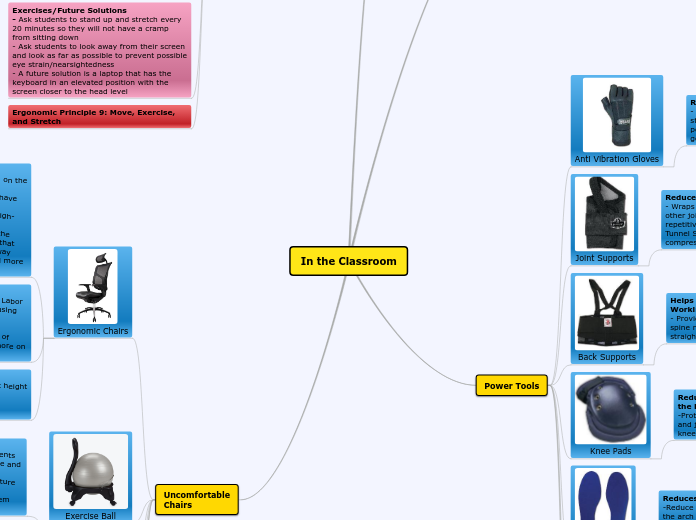In the Classroom
Doors
Automatic Doors
Reduces Injury A LOT
- Do not need to open the door physically; once a student comes near the sensor, the door opens by itself
- Reduces wrist sprains from opening the door incorrectly or trying to open a heavy door -
Exercises/Future Solutions
- A future solution is a door that detects students and it will open. It will stay open until a sensor senses that there is nobody around. The door will then close slowly with a warning light flashing on the top and a sound that the door is closing
Ergonomic Principle 5: Reduce Excessive Motions
Power Tools
Anti Vibration Gloves
Reduces Vibration From the Power Tool
- The gloves are engineered to protect student's hands while working with vibrating power tools such as a drill so students do not get white finger syndrome
Joint Supports
Reduces Stress from the Power Tool
- Wraps and braces for the wrist, ankle, and other joints to help reduce the incidence of repetitive stress injuries such as Carpal Tunnel Syndrome by providing support and compression to the joints
Back Supports
Helps Student Keep a Straight Back while Working with a Power Tool
- Provide support to the lumbar and lower spine region and encourage wearer to keep a straight back when lifting
Knee Pads
Reduces Knee Damage while Working on the Knees with a Power Tool
-Protect the wearer from abrasions and skin and joint damage while working on their knees
Insoles
Reduces Feet Pain while Working
-Reduce foot fatigue and provide support to the arch of the foot. Insoles can be a cost-effective alternative to ergonomic matting
Exercises/Future Solutions
- A future solution is a power tool that does not vibrate while performing the task. For example, if a student is drilling something, the drill would not vibrate anymore so there is no chance of getting white finger syndrome or Carpal Tunnel Syndrome
Ergonomic Principle 2: Reduce Excessive Force
Ergonomic Principle 7: Minimize the Pressure Points
Sitting down in front of a laptop
for the whole class duration
Laptop Stand
Better For the Neck
- Instead of looking down at the laptop screen, the stand
elevates the rear of the laptop so it is inclined
- This means that students are looking straight forward
- Reduces neck strain
Chair Stands
Less Weight on Student's Shoulders
- If a chair is too short, student's arms and shoulders will be hunched in an unhealthy position that can lead to arm and shoulder strains
- A chair stand allows for a taller chair which supports a healthy posture; back straight, elbows at a 90 degree position, and shoulders rolled back
Separate Mouse and Keyboard
Comfortable Mouse and Keyboard Placement
- A laptop's keyboard and trackpad are built in fixed positions, meaning students cannot move them
- A separate mouse and keyboard allows students to move them; this lets them place the mouse and the keyboard at the correct position that makes them comfortable
Exercises/Future Solutions
- Ask students to stand up and stretch every 20 minutes so they will not have a cramp from sitting down
- Ask students to look away from their screen and look as far as possible to prevent possible eye strain/nearsightedness
- A future solution is a laptop that has the keyboard in an elevated position with the screen closer to the head level
Ergonomic Principle 9: Move, Exercise, and Stretch
Uncomfortable
Chairs
Ergonomic Chairs
Boosts Productivity
- Students are in less pain when sitting on the ergonomic chair
- Students who are in good health will have fewer distractions to keep them from performing at their best and creating high-quality work
- Since ergonomic office furniture has the ability to reduce work-related injuries, that means students will spend less time away from work due to illness and injury and more time at the office
Efficiency of Students is Higher
- The Washington State Department of Labor & Industries examined 4000 students using ergonomic chairs
- Has found that 75% of them are less absent, 56% of them have less chance of making errors, and 40% of them are more on task
Many Features
- Adjustable seat height
- Back rest
- Seat depth
- Stability
Exercise Ball
Helps Keep the Body Active
- Body constantly makes minor adjustments to stay balanced, which engages the core and lower back
- No backrest so it encourages good posture
- If students have a habit of fidgeting or moving around, the exercise ball lets them bounce up and down
Ergonomic Stool
Seating is Similar to the Exercise Ball
- High seat encourages students to half-stand with their feet on the floor
-Pivoting base and lack of backrest engages the core and the lower back of the body
Kneeling Chair
Many Beneficial Features
- Chair provides a padded seat
- Angled forward
- Shifts some of the body weight to the shin and knees
- Purpose of the chair is to shift the spine into a more neutral position, taking pressure off the lower back
Exercises/Future Solutions
- If the student is starting to get uncomfortable, stand up and stretch
- However, in whatever circumstance they are not allowed to stand up, students should stretch their legs as far out as possible and try to bend their feet back, which creates a stretch
- A future solution already exists, which are the ergonomic chairs below
Ergonomic Principle 9: Move, Exercise, and Stretch
Ergonomic Principle 10: Maintain a Comfortable Environment
